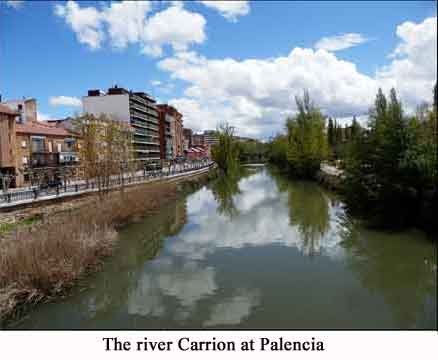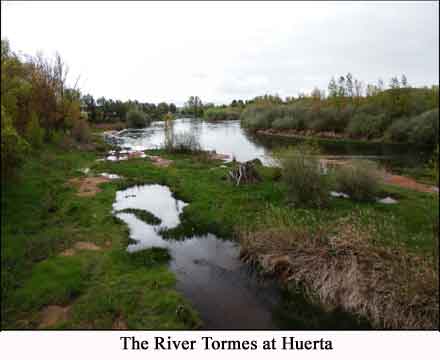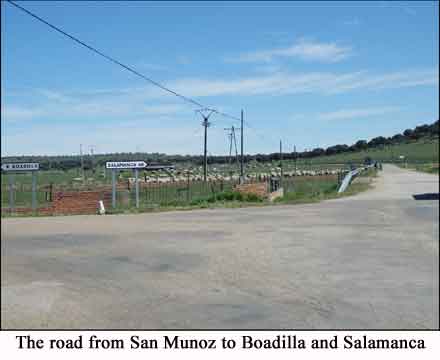
Chapter 40
Wellington's Retreat
into Portugal
October-November 1812
On
October 21st Wellington received news from Hill that King
Joseph and Soult were advancing from Valencia on Madrid
and so decided that he must retreat. Wellington withdrew
on the night of 21st and Pack followed up in the rear
after silently filing his men out of the trenches surrounding
the castle. On the morning of 22nd, two of Wellington’s
columns were at Tardajos and Villa de Buriel. On the night
of 22nd the army was at Celada, Villapequna and Hornillos.
On the 23rd along the road from Celada del Camino to Torqumada. |
 |
On October
24th Wellington crossed the Carrion river by the bridges
of Palencia, Villamuriel and Duenas
and here made his defensive line from Palencia on the
Carrion river to Duenas on the Pisuerga river below its
junction with the river Carrion. However, the French managed
to take Palencia and cross the Carrion, and after other
setbacks Wellington was forced to retreat. He crossed
the Pisuerga river at Cabezon and occupied its east bank.
By blowing up bridges and destroying boats along the Pisuerga,
Wellington was able to prevent the French from threatening
him. However, on the 29th the French made a daring attack
at Tordersillas across the Douro, but Wellington advanced
to within 1200 yards of the crossing in force and threw
up a line of redoubts so strong that the enemy could not
advance. The French forces were now much depleted and
Wellington was in position to defend his line against
any further retreat. [Pack and the 16th Regiment were
at Duenas on the 24th October, Cabezon on the 26th, Tudela
on the 29th and |
Tordesillas
on the 31st October.] Meanwhile, Hill had received orders
from Wellington on 27th October for him to retreat and
meet him at Aravelo on the 4th November. Wellington was
concerned that since he could not hold the French advance,
Hill’s army also would be in danger unless they
combined forces. Hill successfully disengaged himself
from his defence of Madrid and headed north on 30th October,
reaching Villacastin on the 4th November. Here he received
a letter from Wellington telling him he was going to retreat
from the Douro and that Hill should march by Belayos,
Vaillanueva de Gomes, Penavanda to Alba de Tormes near
Salamanca where they would both
meet and move to the San Christobal position outside the
city where they had fought in July. Wellington intended
to hold the line on the Duoro until he had certain news
of how Hill was doing in the south. The French conveniently
remained quiet for six days so Wellington remained on
the Duoro until November 5th. Wellington retreated from
his headquarters at Rueda and on the 6th November |
|
he was at Torrecilla
de la Orden on the 7th and 8th Nov at Pitiegua. On the
8th the whole army was in its old position of the previous
June north of the Tormes river in a semi-circle from Aldea
Lingua to San Christabel with Hill across the Tormes at
Alba. [Pack and the 16th were at Alaejos on the 5th Nov,
Pitiegua on the 7th, and Castellanos on the 8th]. It was
not until the 10th that the French approached his lines
with the Army of the Centre at Macotere, the Army of Portugal
at Balsilafuente and Soult overlooking Alba de Tormes.
After much discussion the French decided to move the bulk
of their army south of Alba to turn Wellington’s
Right Wing. This was executed on 12th and 13th November.
At this time Pack’s Portuguese were on the river
bank at Aldea Lengua and Cabrerizos watching the two Divisions
at Huerta, and on the morning of the 12th the French had
made a reconnaissance in force against Pack’s Portuguese
at Aldea Lengua. On the 14th November Soult had crossed
the Tormes at Galisancho and Lucinos and by the afternoon
the |
 |
whole
army of the South was at Mozarbes, with the Army of the
Centre beginning to follow. Early on 15th November Wellington
advanced from San Christobal with 8,000 infantry but on
arriving in front of Mozarbes at noon realised that he
was greatly outnumbered by Soult. At dusk he ordered Hill
to fall back from Alba and join the whole army on a line
from Calvarisa de Arriba to Miranda de Azan. Soult did
not attack Wellington, but was slowly moving west and
threatening the roads to Cuidad Rodrigo and Wellington’s
line of retreat. Wellington commenced his retreat to Cuidad
Rodrigo on |
 |
November 15th along
the 3 parallel roads via Boadilla, San
Munoz and Anoya de Huerba. Unfortunately the commissariat
had sent off the food supplies towards Roland and San
Felices to the north, resulting in 4 days starvation of
the army.
On the 16th November the army marched from its bivouac
behind the Valmusa river having received no distribution
of food and by that evening were encamped behind the brook
called Matilla. On the 17th November the main column was
marching on San Munoz. Wellington intending to have the
army behind the river Huebra by nightfall, on the plateau
in front of Boadilla and Cabrillas. On the 18th November
the British Army had an unmolested retreat to Sancti Espiritus
and Alba de Yeltes. On the 19th there was a short march
to Ciudad Rodrigo where the army was distributed in quarters
around and behind Ciudad Rodrigo. There were after this
long retreat from Burgos a total of 5,000 missing including
the dead, desertions, prisoners etc. [Pack and the 16th
|
| crossed the bridge
at Salamanca on the 15th Nov. and by the 18th were part
of the centre column marching by Cabrillas towards Ciudad
Rodrigo, where they arrived on the 19th November. From there
they stopped at Fuentes d'Onoro for a week before marching
via Lamego to their winter quarters at Penafiel
near Oporto]. By December the army had distributed itself
into winter quarters in the Mondego valley, in Beira, and
along the Douro. |
Maps
Photos

|













